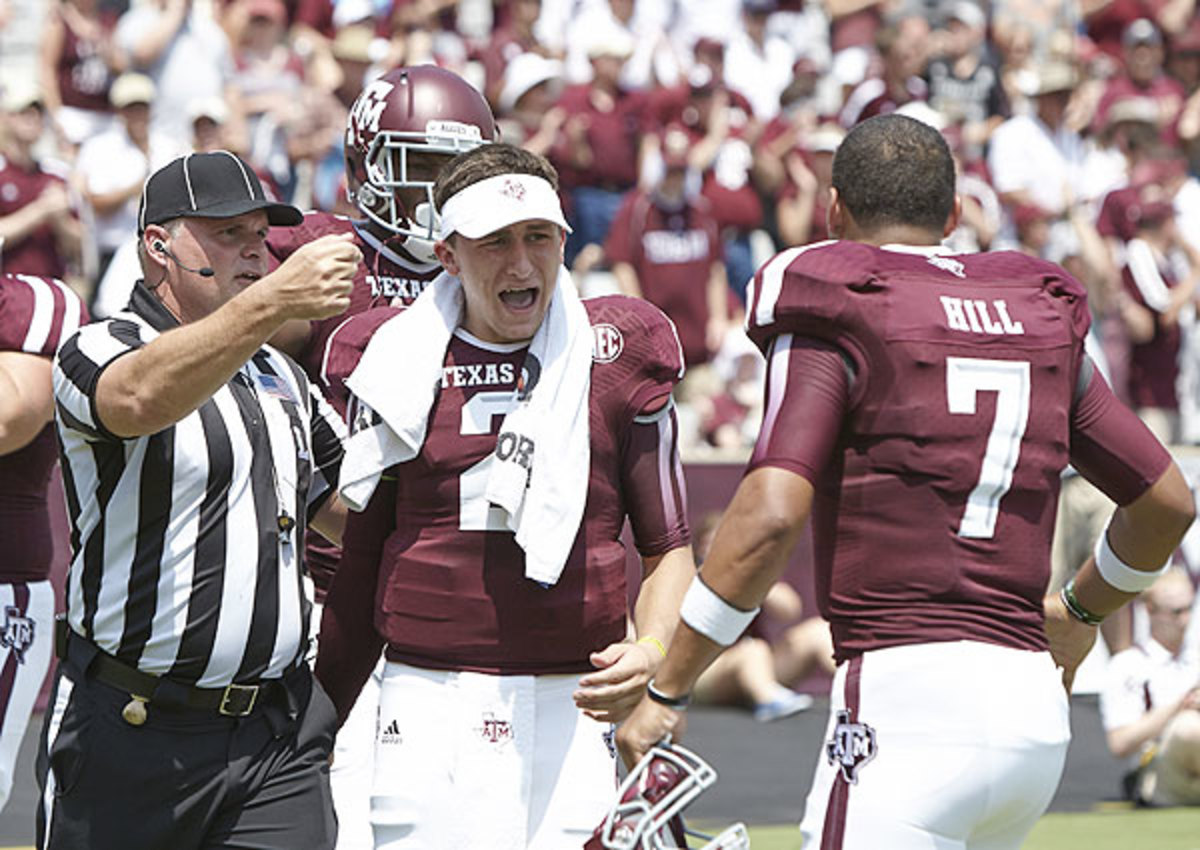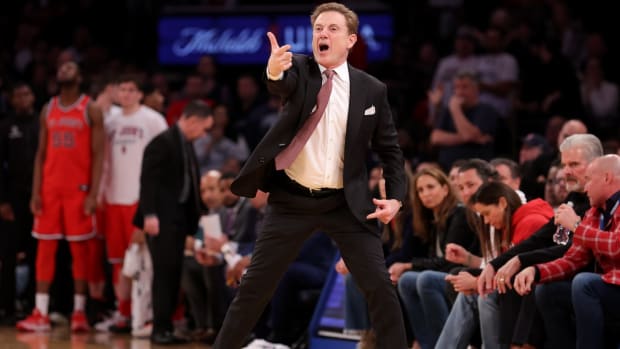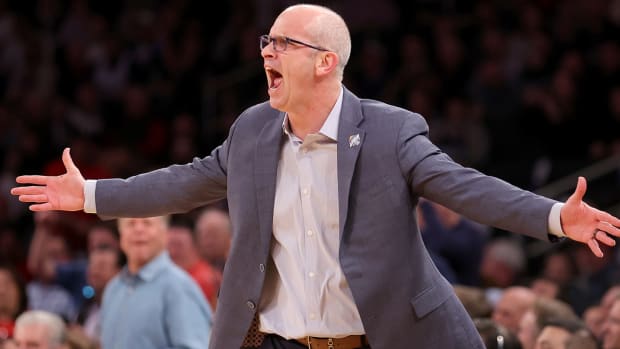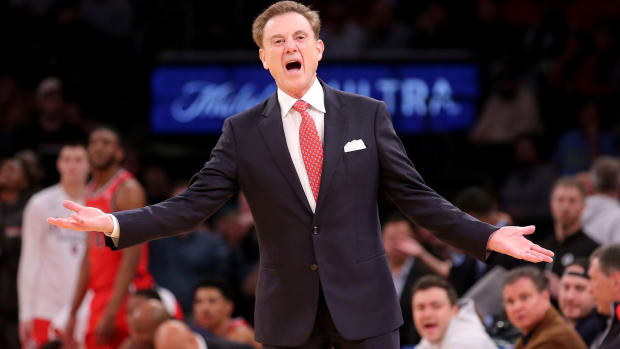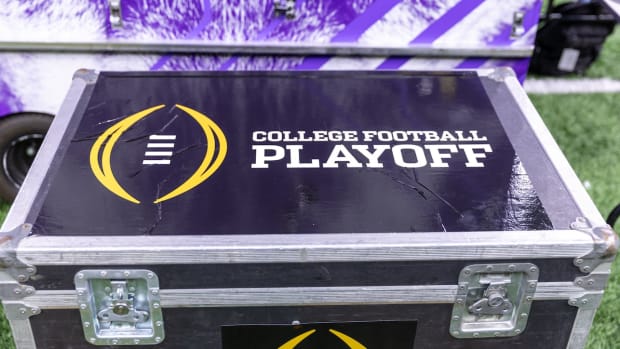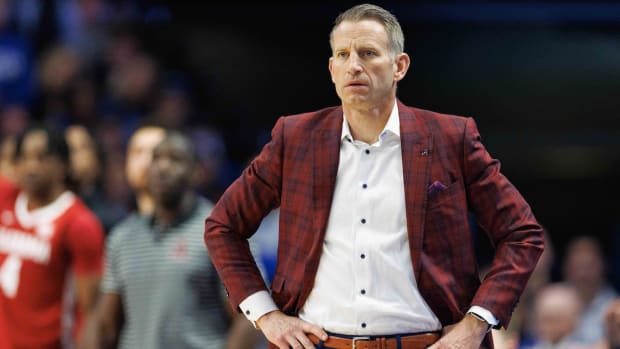O’Bannon v. NCAA, day five: Dan Rascher and the big business of college football
Ratings 'shot up' for Texas A&M's opener against Rice after Johnny Manziel (center) served a first-half suspension. (Erich Schlegel/Sports Illustrated/Getty Images)
If you weren’t sure the NCAA was big business before, then the fifth day of the O’Bannon v. NCAA trial sure hammered that home. Just as it was reported that the NCAA had hired new lobbyists to try and defend the nature of amateurism, in California a majority of Friday's proceedings featured sports economist Dan Rascher, a witness called on by the plaintiffs, trying to establish the NCAA is a lot more like professional sports leagues than it would care to admit.
Rascher previously estimated in unsealed court documents that were revealed back in February that a player on Alabama’s football team in 2010 would have enjoyed a windfall of $47,330 from broadcast revenue that year alone. Over the course of his testimony on Friday, Rascher argued that there was a $1.3 billion surplus from the 69 major conference teams, according to Equity in Athletics Data (EADA), and that the total broadcast revenues from 2005-11 were $6.4 billion in Division I. He went on to explain that the NCAA basketball tournament generates more advertising revenue than any other sporting event in the United States.
This shouldn’t be all that surprising to anyone who flips on a college football or college basketball game over the course of the year. The NCAA tournament is loaded with ads during every commercial break. You’ll see Coca-Cola, Enterprise, McDonald’s, DirecTV, Dish Network, Microsoft, Subway and any other number of brands rotating over the course of the event. It’s so prevalent and wide-ranging that people sometimes spend more time complaining about the ads than they do discussing the games on Twitter. And bowl games themselves are packed with sponsors. Anything and everything can be presented by Vizio, a play of the day can be “Game Changing” because of Pontiac. Allstate’s Good Hands give scholarship money and are plastered on the nets behind the goalposts at every big game, and Tostitos -- well, RIP Tostitos Fiesta Bowl.
That’s all well and good. College sports make money, and they are going to continue to do so. And that isn’t necessarily the crux of the O’Bannon case. The important thing is the revenues from a player's NIL – name, image, likeness – and Rascher used these numbers to establish a baseline before explaining how important winning is to the general college football program.
It’s a basic principle that when a school wins a title, applications go up. There’s an economic impact as well. Rascher detailed that winning programs are more profitable than other programs, even more so than in the case of the NFL. He even referenced a Seinfeld joke -- saying college fans aren’t just rooting for laundry -- which might be a first in a major sports lawsuit.
But Rascher argued that the players are the ones driving that winning. It isn’t just the name on the front of the jersey that determines whether a team will play in a prestigious bowl game or make the NCAA tournament. The names on the back play a big part in that. Rascher pointed out donations at Texas A&M went up to $300 million as a result of the team’s success under Heisman Trophy winner Johnny Manziel.
Even though Manziel was suspended a half of the team’s 2013 opener vs. Rice due to allegations of selling his signature, people still flocked to their sets to watch Johnny Football play. According to Rascher, they weren’t doing that because of his amateurism.
The NCAA would go after the idea of television ratings as a barometer of public opinion during its lawyers' cross-examination of Rascher. The NCAA's argument that ratings for Major League Baseball and the Olympics peaked around 1980, when a poll showed strong sentiment against athletes being paid more, lost steam when NCAA lawyers could not account for the fact that ratings for all types of programs have dropped in the last 30 years. Later, NCAA lawyer RohitSingla attempted to equate the interest in Manziel and Ohio State's stars to the Tonya Harding-Nancy Kerrigan saga that preceded the 1994 Olympics.
Rascher cited that all the financial data available (especially when it comes to EADA numbers) is flawed and that other sources of revenue, including concessions, licensing, parking, merchandise, camps, donations and media coverage do not show up (or aren’t required) on the NCAA forms. Simply put: the big business of college athletics isn’t accurately reported.
While it’s pretty common for schools to report “losing money” when it comes to collegiate athletics, Rascher argued there’s a lot of “gold plating” because the schools have to spend the money somewhere. He referenced a study by economist Brian Goff that said only 10 percent of Division I schools are actually losing money. If more schools were really in trouble, as Rascher pointed out, how would the number of Division I schools continually be growing? And wouldn’t schools be quick to cut football and basketball – huge expenditures – if they were bleeding the university dry?
From an ESPN Outside The Lines study in the beginning of May, Goff intimated that schools tend to hide extra revenue:
Goff said schools have long been trying to keep their actual bottom line "under wraps." "If there's going to be a surplus, you find some expense to put that into often before the surplus even appears," he said.
Goff and other economists say it's not nefarious, but it's a practice common to nonprofit organizations and government entities: Spend as close as you can to what you bring in every year, because there's no incentive to show a profit.
This isn’t cut and dry, of course. While the cash cows of football and basketball are sustainable, the smaller sports (the “Olympic sports”) are in danger, and those are the sports most frequently cut. Those are the things in peril if a school decides it needs to tighten its belt. And if NIL rights are established, that money has to come from somewhere.
While that is a point (and an accurate one) often cited by critics of the pay-for-play model and will likely come into play down the road, it has no bearing in the O’Bannon case. The bottom line (refuting another common argument for the NCAA’s side) Rascher tried to make was this: schools are not going to leave billions in broadcasting money on the table to leave Division I.
Giving players a cut and giving them the rights to their NIL isn’t going to kill college football. If anything, Rascher believes there will be a “greater leap in royalties” and there is even more money to be had. It just might cut into the schools’ (and the NCAA’s) bottom line a bit. Just look at pro leagues’ resistance to free agency over the years. Any time power and money end up being threatened, they get on the defensive. People with lots of money and lots of power want things to stay that way. Like any other big business, the NCAA is going to fight to protect that as hard as they can.
For more analysis of O’Bannon v. NCAA, check out SI.com’s complete coverage hub.
